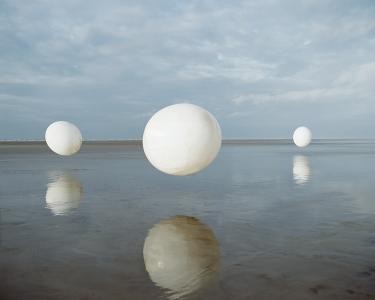Daniel Roth
21 Mar - 25 Apr 2009
Daniel Roth
Portmeirion, Gwyllt Woods
21 Mar 2009 - 25 Apr 2009
Portmeirion, Gwyllt Woods, a peninsula in the north of Wales, is famous for its atypical climate and beautiful scenery. Its history boasts a number of remarkable individuals. Take the late nineteenth-century inhabitant Adelaine Haight, for instance. After firing her gardeners, she lived amid an increasingly impenetrable wilderness with only stray dogs for company. In the evenings she used to read aloud to the dogs. Around the 1930s, the land was purchased by one Clough Ellis Williams, who built a fairy-tale like estate there, but without intending it to serve as human habitation. Once again nature overwhelmed the built environment, and the remains of his creation lies concealed beneath the greenery. In the 1960s the TV series The Prisoner was shot in Portmeiron. In this series, the area was portrayed as an island that was cut off from the outside world. A large, white, balloon-shaped robot (rather like a weather balloon in appearance) guarded the inhabitants, preventing anyone from entering or leaving the island.
Daniel Roth has assembled drawings, photos and installations to produce non-linear narratives related to specific existing locations, most notably their topography and history, which in this case is the peninsula of Portmeirion in Wales. The compilation is inconsistent, shifting between past, present and future, and between fact and fiction. Roth plays with the tension evoked by this remote place with its unusual inhabitants; it makes an ideal background for possible stories.
Roth’s works are abstracted but imaginative approaches to his chosen narratives. They provide additional layers of meaning that overlap with the existing stories of Portmeirion. The sculptures appear to be ruins, which do not refer literally to known elements of one of the stories but might nonetheless be relics of them. Two large, tapering anthracite blocks, Two Towers (2008) with cavities and broken edges, tower over the scene from the middle of the exhibition space, like the remains of towers built by Clough Ellis Williams. The Photograph is poetic and it radiates a certain tension, with a suggestion of a gate opening onto a hidden world. Some drawings display the architecture of an interior, abstract and full of tension, but violating the laws of reality. A muted organic form can be discerned in them: nature will engulf the whole. Other drawings and installations, in minimalist scored lines and forms, are literally masks, caps or other possible coverings, analogous to the different layers of history, stories and ruins that cover the topography of Portmeirion. The remote and well-preserved nature of this place acts like a time-capsule, keeping it in a state of suspended animation.
Portmeirion, Gwyllt Woods
21 Mar 2009 - 25 Apr 2009
Portmeirion, Gwyllt Woods, a peninsula in the north of Wales, is famous for its atypical climate and beautiful scenery. Its history boasts a number of remarkable individuals. Take the late nineteenth-century inhabitant Adelaine Haight, for instance. After firing her gardeners, she lived amid an increasingly impenetrable wilderness with only stray dogs for company. In the evenings she used to read aloud to the dogs. Around the 1930s, the land was purchased by one Clough Ellis Williams, who built a fairy-tale like estate there, but without intending it to serve as human habitation. Once again nature overwhelmed the built environment, and the remains of his creation lies concealed beneath the greenery. In the 1960s the TV series The Prisoner was shot in Portmeiron. In this series, the area was portrayed as an island that was cut off from the outside world. A large, white, balloon-shaped robot (rather like a weather balloon in appearance) guarded the inhabitants, preventing anyone from entering or leaving the island.
Daniel Roth has assembled drawings, photos and installations to produce non-linear narratives related to specific existing locations, most notably their topography and history, which in this case is the peninsula of Portmeirion in Wales. The compilation is inconsistent, shifting between past, present and future, and between fact and fiction. Roth plays with the tension evoked by this remote place with its unusual inhabitants; it makes an ideal background for possible stories.
Roth’s works are abstracted but imaginative approaches to his chosen narratives. They provide additional layers of meaning that overlap with the existing stories of Portmeirion. The sculptures appear to be ruins, which do not refer literally to known elements of one of the stories but might nonetheless be relics of them. Two large, tapering anthracite blocks, Two Towers (2008) with cavities and broken edges, tower over the scene from the middle of the exhibition space, like the remains of towers built by Clough Ellis Williams. The Photograph is poetic and it radiates a certain tension, with a suggestion of a gate opening onto a hidden world. Some drawings display the architecture of an interior, abstract and full of tension, but violating the laws of reality. A muted organic form can be discerned in them: nature will engulf the whole. Other drawings and installations, in minimalist scored lines and forms, are literally masks, caps or other possible coverings, analogous to the different layers of history, stories and ruins that cover the topography of Portmeirion. The remote and well-preserved nature of this place acts like a time-capsule, keeping it in a state of suspended animation.

